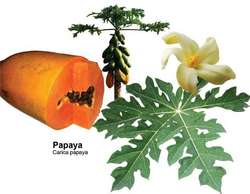papaya
a Caribbean evergreen tree, Carica papaya, with a crown of large dissected leaves and large green hanging fruit: family Caricaceae
Collins Discovery Encyclopedia, 1st edition © HarperCollins Publishers 2005
papaya
Grows up to 30ft (10m) High in vitamin A, B, C, carotenoids, fiber, phytochemicals, phenols, enzymes and anti-fungals. Ripe fruit can be eaten with skin and seeds. Unripe fruit is usually cooked. Young leaves also edible and used against malaria. Seeds are anti-parasite and can be ground and used like black pepper. Fruit is high in papain, a proteindigesting enzyme. Green papayas used in some parts of the world as a contraceptive and abortive if eaten in large amounts. Seeds even used for male contraception. Reduces effects of progesterone. Papaya juice used for cancer therapy. Papayas are used for E. Coli, Staph, Salmonella and other infections, both bacterial and viral. Great for digestion, indigestion, gas, heartburn, helps digest food. A great desert simply cut open, squeeze lemon on top, spoon fresh out of skin.
Edible Plant Guide © 2012 Markus Rothkranz
The following article is from The Great Soviet Encyclopedia (1979). It might be outdated or ideologically biased.
Papaya
(Carica papaya), a fruit tree of the family Papayaceae (Caricaceae). Five to seven large fingerlike leaves on long stems are attached in bunches at the top of a short (4-8 m) branchless trunk. The dioecious blossoms are yellowish white. The stamens are in the racemes, and the pistils, which grow singly, are in the axil. The flowers are either diclinous or hermaphroditic. Although the papaya grows rapidly without special soils, its life span is short and it cannot survive frost. The papaya is cultivated in the tropics; a wild counterpart is not known. Its fruit, which resembles a melon, is used for food, and its milky juice is used to make the enzyme papain.
REFERENCE
Siniagin, I. I.Tropicheskoe zemledelie. Moscow, 1968.S. K. CHEREPANOV
The Great Soviet Encyclopedia, 3rd Edition (1970-1979). © 2010 The Gale Group, Inc. All rights reserved.
